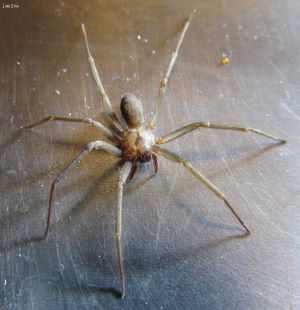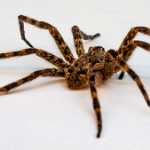
When they see a spider, most people will back off quickly or try to kill it.
Dogs, unfortunately, have no fear of a tiny insect, and, being very inquisitive by nature, they run the risk of getting a nasty spider bite.
Not all spiders are venomous, but a brown recluse can cause a serious injury. Can a brown recluse kill a dog outright?
The good news is that a brown recluse bite won’t kill a dog, at least not directly.
The bad news is that such a bite can be very painful and can trigger a deadly infection if left untreated.
Here’s all you need to know about brown recluse spiders, how to recognize the signs of venom poisoning, and how to treat the wound.
What are brown recluse spiders?
Also known as the fiddle spider, the brown recluse is widespread in the central and southern parts of the United States. It can be found in Kansas, Oklahoma, Texas, Louisiana, Arkansas, Missouri, Mississippi, Alabama, and parts of Georgia, Tennessee, Kentucky, Ohio, Indiana, Illinois, Iowa, and Nebraska. Outside of this area, it’s highly unlikely to run into a brown recluse spider, but there are others to watch out for.
Its scientific name is Loxosceles reclusa and is part of the Loxosceles genus of spiders.
How to spot a brown recluse
All spiders in this group can be easily identified by the violin-shaped markings on their back, which is why they are sometimes referred to as violin spiders. In adult spiders, the markings on the back will be of a dark brown.
Another distinctive characteristic is the brown recluse’s eyes. These spiders have six eyes arranged in three pairs, while others have eight eyes set in two rows of four.
The body of a recluse isn’t more than 3/8-inch (1 cm) in length and it has uniformly colored legs with no patterns or spines on them.
If your dog gets bitten by a spider it’s highly unlikely that the culprit will stay around long enough for you to identify it, but if your pet develops a nasty wound you might want to inspect the house and call pest control.
Preferred hiding spots
These are nocturnal creatures that feed on insects such as crickets or silverfish. During the day they hide in dark sheltered spaces. They can be found in hollow trees or rock cracks, but also around the house in boxes, shoes, trash cans, etc. Brown recluse spiders keep to themselves mostly, but they tend to be more reckless during mating season when males venture outside of their hiding places to look for females.
Keep in mind that the female of the species needs to mate only once to produce fertilized eggs throughout her life. A brown recluse can produce 150 or more spiderlings in a year, so you will have a serious problem if one gets into your house.
Would a brown recluse spider attack a dog?
Brown recluse spiders do not attack humans or animals unprovoked. A dog, however, might provoke the spider unintentionally by sticking his nose where he has no business. In most cases, a brown recluse will bite a dog if he walks into its web or sits on it.
How to identify a spider bite?
A brown recluse spider bite doesn’t cause pain, so don’t expect your dog to yelp, unless the insect attacks a very sensitive part of his body. Yet, once the venom gets inside it will start working and you will see the signs in 2-8 hours. The dog will develop a red skin lesion around the site. This type of bite can be very itchy, which can complicate matters as the dog will try to scratch himself and this can lead to an infection that has nothing to do with the original bite.
One of the characteristics of a brown recluse bite is the bullseye look, with a white center. You may also notice blisters and swelling at the site.
The main problem with a brown recluse bite is that it causes necrosis or cell death. The affected area will turn black, and the dead cells will start falling off, leaving a gaping wound. It may be months till the wound heals and you should check it regularly for signs of infection.
Can a brown recluse bite kill a dog?
There are no known incidents of this type, but you need to be very careful with a brown recluse bite if you have a small dog. A toy dog may develop a serious infection if enough venom is injected. This can lead to blood clots, anemia, and kidney failure.
The worst thing is that there is no antidote to brown recluse venom, but the vet might prescribe corticosteroids to reduce the chances of a systemic infection.
Symptoms of brown recluse bite poisoning in dogs
Since you probably won’t be around to witness the spider biting your pet, you will be very surprised when the dog starts feeling ill. Here are the symptoms that can help you understand you’re dealing with a dog bite and not another health issue.
- Pain, or reluctance to put weight on one leg
- Signs of pain, the dog won’t let you touch the affected area
- Red, itchy lesion with a bullseye look
- Swelling or blistering
- Local inflammation
- Necrotic tissue, skin turns black around the bite site
- Hole after the damaged tissue has fallen off
- Scabs that take months to heal
A spider bite is unpleasant to deal with, but what you should really worry about is a systemic infection. Small dogs or pets with a compromised immune system are more susceptible to such an infection. Look out for symptoms such as:
- Fever
- Excessive thirst
- Nausea and vomiting
- Water retention (edema)
Left untreated a systemic infection can lead to kidney failure, shock, and death.
How is brown recluse bite poisoning diagnosed?
If you notice any of the above symptoms and your dog has an insect bite mark you should take him to the vet as soon as possible. The vet will probably want to know if you’ve seen the spider. A description of the spider can help identify a brown recluse, so the doctor will know it’s serious.
If your dog is seriously unwell the vet will run some blood tests, looking for signs of anemia or systemic infection.
How is brown recluse bite poisoning treated?
If you happen to notice the bite mark early on, you should try to disinfect the wound. You can give your dog a quick bath to clean the wound with water and soap. Apply a bit of hydrogen peroxide to the area, then apply any antiseptic ointment you have around the house.
If the area around the bite is already swollen gently apply an ice pack to reduce inflammation.
Head to the vet right away, especially if you have a smallish sensitive dog. Corticosteroids treatment is most effective if administered early on. Corticosteroids work by preventing the necrosis from spreading too much and they can protect against systemic shock.
Other than that, the vet might prescribe fluids and electrolytes to help the dog’s body fight off the infection.
In case of severe poisoning, your dog will require a blood transfusion to counter blood clots and anemia.
There is no antidote, but in severe cases, a vet might prescribe dapsone, which is a drug used for leprosy. Your dog might have to spend the night at the clinic for monitoring.
If the dog seems fine, except for the wound, your dog might prescribe a course of antibiotics to prevent infection.
You will have to clean the wound several times a day with an antiseptic solution and you might have to apply a bandage. This can be useful to keep the dog from scratching at the wound, but not many dogs will tolerate one, especially if it’s in an area they can easily reach.
If the dog has trouble breathing, oxygen therapy may be required.
Tetanus shots are recommended if the dog has been exploring some dark dusty corner or has been rolling in the dirt.
What other spiders are dangerous to dogs?
While the brown recluse spider lives only in certain parts of the US, other types of venomous spiders can be found pretty much everywhere in the world. According to experts, there are around 30 types of spiders that can severely harm or even kill a dog.
Black widow
Famous for the fact that females of the species kill and devour their partners right after mating, black widow spiders are very dangerous to both humans and dogs. The neurotoxin injected by a black widow can cause severe muscle pain and cramping, nausea, and mild paralysis of the diaphragm, which makes breathing difficult. Such a bite could be fatal to a very small dog.
Brazilian wandering spider
Although the name indicates this type of spider is most common in Brazil, it can travel the world hidden in banana cases. There have been cases of infestation with Brazilian wandering spiders in various parts of the world. This is one of the most dangerous spiders as the bite of this insect can cause an irregular heartbeat.
Brown widow
This type of spider originates in Africa, but it has managed to make its way to faraway places such as the US, Australia, and Europe. The venom of the brown widow is twice as deadly as that of its black sister, but fortunately, it only injects a small amount of toxin when it bites.
Wolf spider
There are around 125 species of wolf spiders living in North America and some 50 species in Europe. The bite of a wolf spider is not considered lethal, but some people can be allergic to their venom. There are no studies on potential allergy risk in dogs.
However, the bite can be extremely painful as these spiders have long fangs.
Yellow sac spider
Yellow sac spiders are common throughout the Americas. The toxin they inject can destroy cells, but a bite rarely leads to necrosis of the tissue.
Closing thoughts
Brown recluse spiders are very dangerous to dogs, but in most cases, a bite won’t be lethal. However, a dog will suffer a lot as the bite can turn necrotic. The bite site will become black in a matter of days and as the dead cells start falling off they will leave behind a large hole. Such wounds may take months to heal.
If your dog is small or has a weak immune system you must take it to the vet as soon as you notice symptoms indicating a spider bite. Left untreated, such a bite can lead to anemia, organ failure, systemic infection, and even death.
Photo credits





